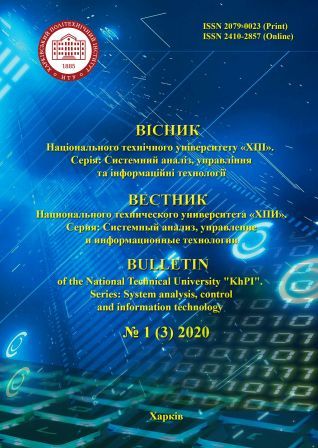QUANTITIVE RISK ANALISYS OF IT-STARTUPS
DOI:
https://doi.org/10.20998/2079-0023.2020.01.10Keywords:
IT-startup, quantitative risk analysis, model, analysis of the sensitivity, scripting method, imitation modelAbstract
When working with an IT startup, a young developer will always encounter difficulties in analyzing risks. Since there are quite a few options and methods for analysis, it was decided to investigate some of the most effective methods of risk analysis. Also, the implementation of a startup, as a rule, is based on attracting external financing. But more often than not, the investor is interested not only how effective this project is in case of its successful implementation, but also what is the likelihood of a positive effect, that is, how much all risk factors capable of influencing the project are taken into account. So, one more confirmation of the relevance of the application of risk analysis is help in finding sources of project financing. The aim of the study is to analyze possible methods for quantitative risk analysis of an IT startup, with consideration of the most practica l methods for solving risk analysis tasks. The advantages of a qualitative risk assessment are the ease of understanding and implementation, the ability to rank risks using characteristics or color codes. Outwardly, the methodology for a qualitative assessment of project risks seems very simple – descriptive, but in essence it should lead the analyst to a quantitative result, that is, a valuation of the identified risks, their negative consequences and stabilization measures. In the process of research, we consider: the method of reliable equivalents, the scenario method, sensitivity analysis, and the Monte Carlo method. The goal as a result is to simplify the risk analysis for IT startups, as well as to achieve maximum efficiency and understanding the degree of influence of risks on IT startups for their further elimination or mitigation.References
Fama E. F., French K. R. The Capital Asset Pricing Model: Theory and Evidence. Journal of Economic Perspectives. 2004, vol. 18, no. 3, pp. 25–46. Available at: http://www.ssrn.com/link/Chicago-BoothFama-Miller-RES.html (accessed 07.08.2019).
Sirotkin S. A., Kelchevskaya N. R. Ekonomicheskaya ocenka investicionnyh proektov: uchebnik dlya studentov vuzov, obuchayushchihsya po special'nosti "Ekonomika i upravlenie na predpriyatiyah (po otraslyam)" [Economic evaluation of investment projects: a textbook for university students enrolled in the specialty "Economics and Management at Enterprises (by Industry)"]. Moscow, UNITY-DANA Publ., 2017. 311 p.
Kossov V. V., Livshic V. N., Shahnazarov A. G. et al..Metodicheskie rekomendacii po ocenke effektivnosti investicionnyh proektov [Methodological recommendations for assessing the effectiveness of investment projects (second edition)]. Moscow, Ekonomika Publ., 2000. 421 p.
Algoritm analiza chuvstvitelnosti [Sensitivity analysis algorithm]. Available at: https://www.masterplans.ru/analiz_chuvstvitelnosti.html (accessed 12.08.2019).
Metod scenariev ucheta riska proekta [The project risk accounting scenario method]. Available at: https://knigi.news/invest/metodstsenariev-imitatsionnaya-model-otsenki-17406.html (accessed19.08.2019).
Pease Christopher. An Monte Carlo method. Available at https://towardsdatascience.com/an-overview-of-monte-carlomethods-675384eb1694 (accessed 10.08.2019).
Alvares Sindy. Lean Customer Development: Building Products Your Customers Will Buy. O'Reilly Media Publ., 2017. 240 p. (Russ. ed.: Alvares Sindy. Kak sozdat produkt, kotoryj kupyat: Metod Lean Customer Development. Moscow, Alpina Publ., 2018. 290 p.).
Derhami S., Smith A.E. An Integer Programming Approach for Fuzzy Rule-Based Classification Systems. European Journal of Operational Research. 2017, Vol. 256, issue 3, pp. 924–934.
Lukash Y. A. Analiz finansovoj ustojchivosti kommercheskoj organizacii i puti eyo povysheniya: Uchebnoe posobie [Analysis of the financial stability of a commercial organization and ways to improve it: Textbook]. Moscow, Flinta Publ., 2017. 280 p.
Degtyariova O. I., Upravlenie riskami v mezhdunarodnom biznese [Risk management in international business] Moscow: Flinta Publ., 2014. 380 p.
Givetin V. B. Vvedenie v teoriyu riska (dinamicheskih sistem) [Introduction to risk theory (dynamic systems)]. Moscow, Institut problem riska Publ., OOO Informacionno-izdatelskij centr "Bon Anca" Publ., 2009. 622 p.
Vose David. Risk analysis: A quantitative guide. John Wiley & Sons, 2008. 729 p.
Downloads
How to Cite
Issue
Section
License
Copyright (c) 2020 Bulletin of National Technical University "KhPI". Series: System Analysis, Control and Information TechnologiesAuthors who publish with this journal agree to the following terms:
- Authors retain copyright and grant the journal right of first publication with the work simultaneously licensed under a Creative Commons Attribution License that allows others to share the work with an acknowledgement of the work's authorship and initial publication in this journal.
- Authors are able to enter into separate, additional contractual arrangements for the non-exclusive distribution of the journal's published version of the work (e.g., post it to an institutional repository or publish it in a book), with an acknowledgement of its initial publication in this journal.
- Authors are permitted and encouraged to post their work online (e.g., in institutional repositories or on their website) prior to and during the submission process, as it can lead to productive exchanges, as well as earlier and greater citation of published work (See The Effect of Open Access).


